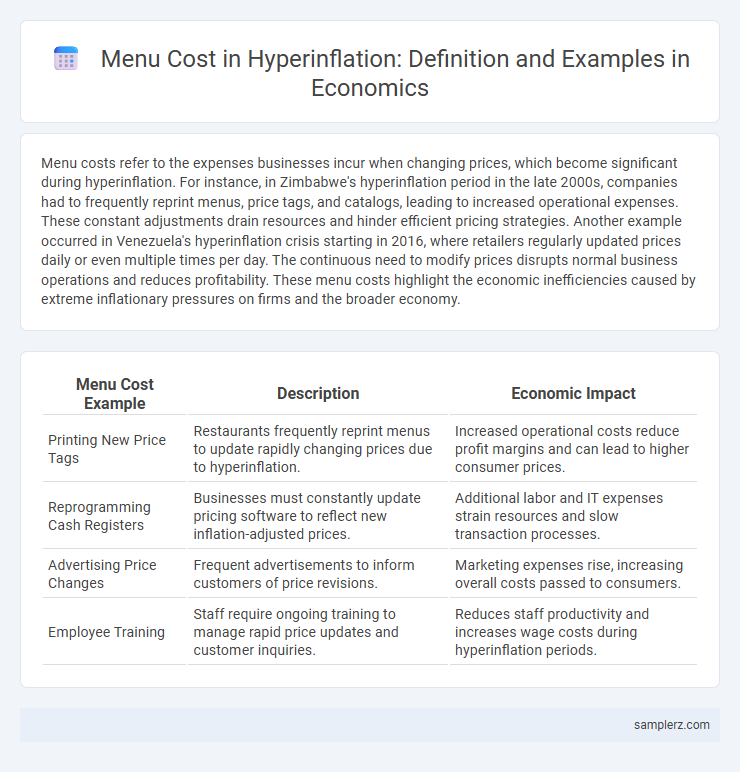Menu costs refer to the expenses businesses incur when changing prices, which become significant during hyperinflation. For instance, in Zimbabwe's hyperinflation period in the late 2000s, companies had to frequently reprint menus, price tags, and catalogs, leading to increased operational expenses. These constant adjustments drain resources and hinder efficient pricing strategies. Another example occurred in Venezuela's hyperinflation crisis starting in 2016, where retailers regularly updated prices daily or even multiple times per day. The continuous need to modify prices disrupts normal business operations and reduces profitability. These menu costs highlight the economic inefficiencies caused by extreme inflationary pressures on firms and the broader economy.
Table of Comparison
| Menu Cost Example | Description | Economic Impact |
|---|---|---|
| Printing New Price Tags | Restaurants frequently reprint menus to update rapidly changing prices due to hyperinflation. | Increased operational costs reduce profit margins and can lead to higher consumer prices. |
| Reprogramming Cash Registers | Businesses must constantly update pricing software to reflect new inflation-adjusted prices. | Additional labor and IT expenses strain resources and slow transaction processes. |
| Advertising Price Changes | Frequent advertisements to inform customers of price revisions. | Marketing expenses rise, increasing overall costs passed to consumers. |
| Employee Training | Staff require ongoing training to manage rapid price updates and customer inquiries. | Reduces staff productivity and increases wage costs during hyperinflation periods. |
Definition of Menu Costs in Hyperinflationary Economies
Menu costs in hyperinflationary economies refer to the significant expenses businesses incur when continuously updating prices due to rapid and extreme inflation rates, such as the over 50% monthly inflation seen in Zimbabwe during the late 2000s. These costs include printing new menus, re-tagging goods, and adjusting accounting systems, which reduce overall economic efficiency and increase operational burdens. High menu costs discourage frequent price adjustments, leading to price rigidity despite volatile currency values.
Real-World Examples: Restaurants Facing Frequent Price Changes
Restaurants in Zimbabwe during the 2008 hyperinflation frequently updated menus several times a day to keep up with skyrocketing prices, reflecting extreme menu costs. In Venezuela's ongoing inflation crisis, eateries regularly print new menus to account for the rapidly depreciating bolivar, increasing operational expenses. These frequent price adjustments highlight the real economic burden menu costs impose on food service businesses in hyperinflationary environments.
Retail Sector: Shelves and Tag Updates During Hyperinflation
In hyperinflationary environments, retail stores face soaring menu costs as they must frequently update price tags and shelf labels to reflect rapidly changing prices. These constant adjustments increase operational expenses due to material costs and employee time dedicated to re-tagging products, disrupting inventory management and customer experience. Retailers also incur efficiency losses as price volatility forces continuous recalibration of pricing strategies in efforts to maintain profitability amidst economic instability.
Technology's Role in Managing Menu Costs
In hyperinflationary environments, businesses leverage digital pricing technologies such as automated pricing software and real-time data analytics to minimize menu costs by rapidly adjusting prices without physical reprinting. Cloud-based platforms and mobile point-of-sale systems enable instant updates across multiple locations, reducing labor and material expenses linked to frequent price changes. These technological advancements improve operational efficiency and help companies maintain profit margins despite volatile currency fluctuations.
Case Study: Zimbabwe’s Hyperinflation and Menu Cost Impact
Zimbabwe's hyperinflation in the late 2000s, with inflation rates exceeding 79.6 billion percent month-on-month in November 2008, exemplifies extreme menu costs as businesses constantly updated prices on menus, labels, and catalogs to keep pace. Retailers faced substantial costs due to frequent reprinting and communication of new prices, eroding profit margins and disrupting normal market transactions. This case underscores how hyperinflation-induced menu costs contribute to economic inefficiencies and reduced consumer purchasing power.
The Burden on Small Businesses in Hyperinflation
Small businesses face severe menu costs in hyperinflation, as they must constantly update prices to keep pace with rapidly eroding currency value. Frequent price changes increase operational expenses, including printing new menus, re-tagging products, and adjusting accounting systems, which strain limited financial resources. These persistent costs reduce profit margins and can hinder small business survival during sustained hyperinflationary periods.
Hospitality Industry Struggles: Daily Price Revisions
In hyperinflation, the hospitality industry endures severe menu costs as daily price revisions become necessary to keep pace with rapidly devaluing currency. Restaurants and hotels must frequently reprint menus, update digital pricing systems, and retrain staff, increasing operational expenses significantly. These continuous adjustments erode profit margins and complicate financial planning during economic instability.
Menu Costs and Supply Chain Adjustments
Hyperinflation dramatically increases menu costs as businesses frequently update prices to keep pace with rapidly devaluing currency, leading to substantial printing and administrative expenses. Supply chain adjustments further compound these costs by disrupting procurement schedules and forcing constant renegotiations with suppliers under volatile price conditions. This dynamic environment necessitates agile inventory management and quick adaptation to fluctuating input costs to maintain operational viability.
Consumer Behavior Shifts Due to Frequent Price Updates
During hyperinflation, consumers rapidly adjust their purchasing behavior as frequent price updates force businesses to frequently reprint menus and price tags, incurring significant menu costs. This constant price volatility leads consumers to prioritize bulk buying and immediate consumption to avoid future price increases. Consequently, consumer demand becomes highly elastic, reflecting sensitivity to short-term price fluctuations and altering overall market dynamics.
Coping Strategies: How Businesses Minimize Menu Costs in Hyperinflation
Businesses adopt coping strategies such as digital pricing tools that enable rapid menu updates to minimize menu costs during hyperinflation, avoiding frequent printing expenses. Dynamic pricing algorithms linked to real-time inflation data help retailers adjust prices frequently without physical alterations. Firms also use standardized price increments and electronic displays to reduce operational disruptions and maintain customer trust amid volatility.

example of menu cost in hyperinflation Infographic
 samplerz.com
samplerz.com